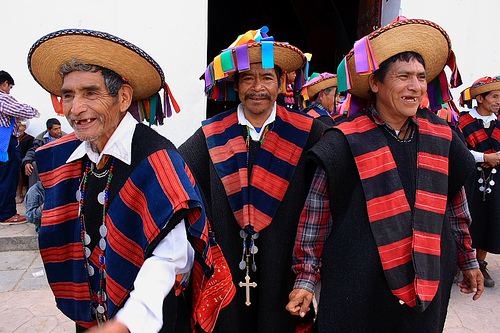Mexico’s indigenous groups have long been a rich resource for investigations of all manner of research concerning culture, linguistics and sociology.
In this post, we consider Spatial Reasoning Skills in Tenejapan Mayans, a study relating to geographic reasoning, which relied on the participation of indigenous Tseltal-speaking Maya in Tenejapa (Chiapas), southern Mexico.
According to the inter-census population count in 2005, Tseltal (aka Tzeltal) is spoken by 371,730 individuals over the age of 5, making it Mexico’s fifth most-spoken indigenous language (after Náhautl, Maya or Yucatec Maya, Mixtec and Zapotec). More than 25% of Tseltal speakers are monolingual and do not speak Spanish. They reside in several municipalities of Chiapas, including Ocosingo, Altamirano, Tenejapa, Chanal, Sitalá, Amatenango del Valle, San Cristóbal de las Casas and Oxchuc.
Peggy Li, Linda Abarbanell and Anna Papafragou, the authors of the study, examined the “possible influences of language on thought in the domain of spatial reasoning.”
They distinguished between egocentric orientation and geocentric orientation:
“Language communities differ in their stock of reference frames (coordinate systems to reference locations and directions). English typically uses egocentrically-defined axes (“left-right”). Other languages like Tseltal lack such a system but use geocentrically-defined axes (“north-south”).”
They then compared how a group of Tseltal speakers tackled simple orientation tasks that required egocentric spatial reasoning skills. Their expectation was that Tseltal speakers would be poor at these tasks compared to a control group of Tseltal speakers who also spoke Spanish (which has many egocentric words).
The expectation was that Tenejapans would find egocentric reasoning much harder than geocentric spatial reasoning since their language has no egocentric vocabulary for anything beyond their own bodies. [Tseltal “does have two “body part words “xin” (left) and “wa’el” (right)”, though they are never used for anything outside the body.] This expectation was based in part on an earlier anecdotal report that “a Tenejapan blindfolded and spun around 20 times in a darkened house was able to point in the agreed [compass] direction while still dizzy and blindfolded”.
To some people’s surprise, the Tseltal speakers were able to solve tasks requiring egocentric skills at a rate far higher than mere chance would suggest, and indeed with a higher success rate than tasks requiring geocentric skills. The researcher concluded that tasks requiring egocentric spatial orientation skills are actually easier than those requiring geocentric spatial orientation, and that the absence of “left/right” in a language does not necessarily translate into any conceptual gap.
If Tseltal speakers don’t use “left and right” to locate objects, how do they describe where things are?
“In place of egocentric coordinates, Tenejapans and other Tseltal speakers utilize a system of terms (“alan” and “ajk’ol”) based on the overall inclination of the terrain (“downhill” and “uphill”) which they inhabit. These geocentrically-defined terms are extended and used even when one is on flat terrain to reference the general directions of uphill and downhill which roughly correspond to the north-south axis. Moreover, they are used in descriptions of small scale arrays such as the arrangement of items on tabletops for which English speakers prefer “left” and “right.” ”
We hope the Tenejapans (each received 50 pesos for participating) did not give all their secrets away at once, but have saved some for the enlightenment of future researchers…
Li, P., Abarbanell, L.,& Papafragou, A. (2005). Spatial reasoning skills in Tenejapan Mayans. Proceedings from the 27th Annual Meeting of the Cognitive Science Society. Hillsdale, NJ: Erlbaum.
